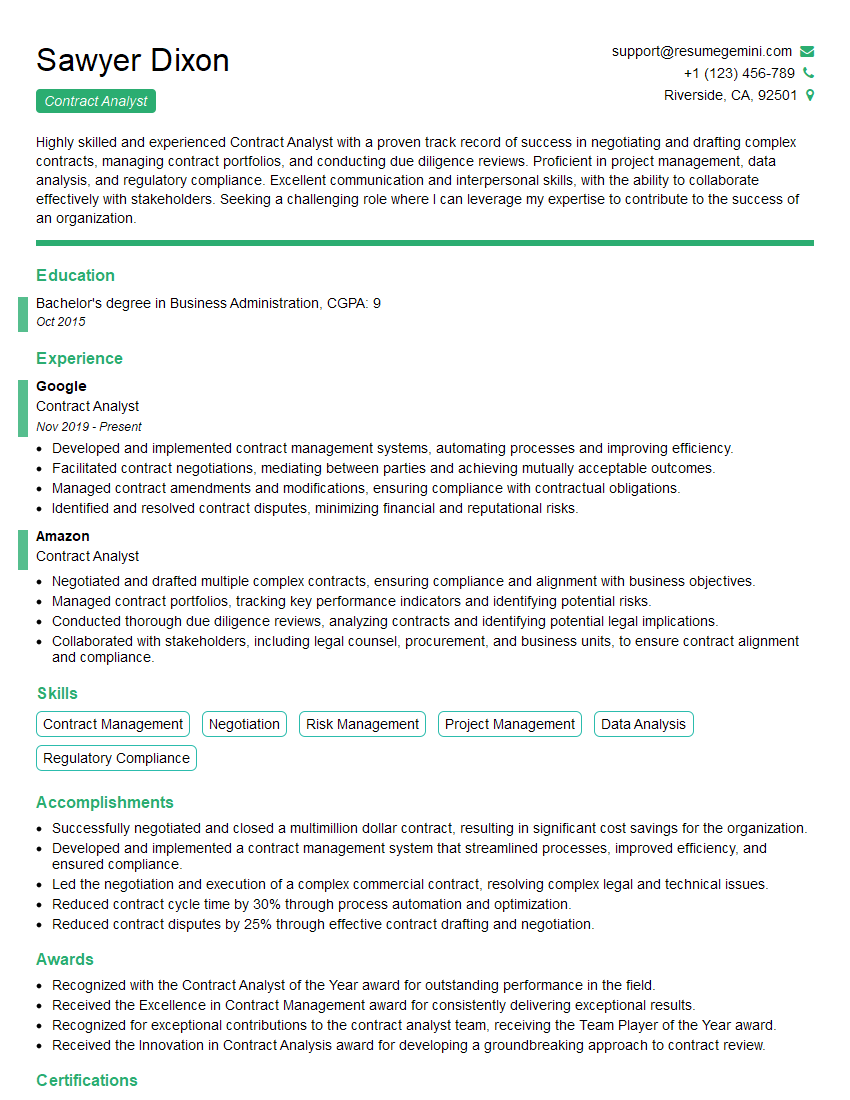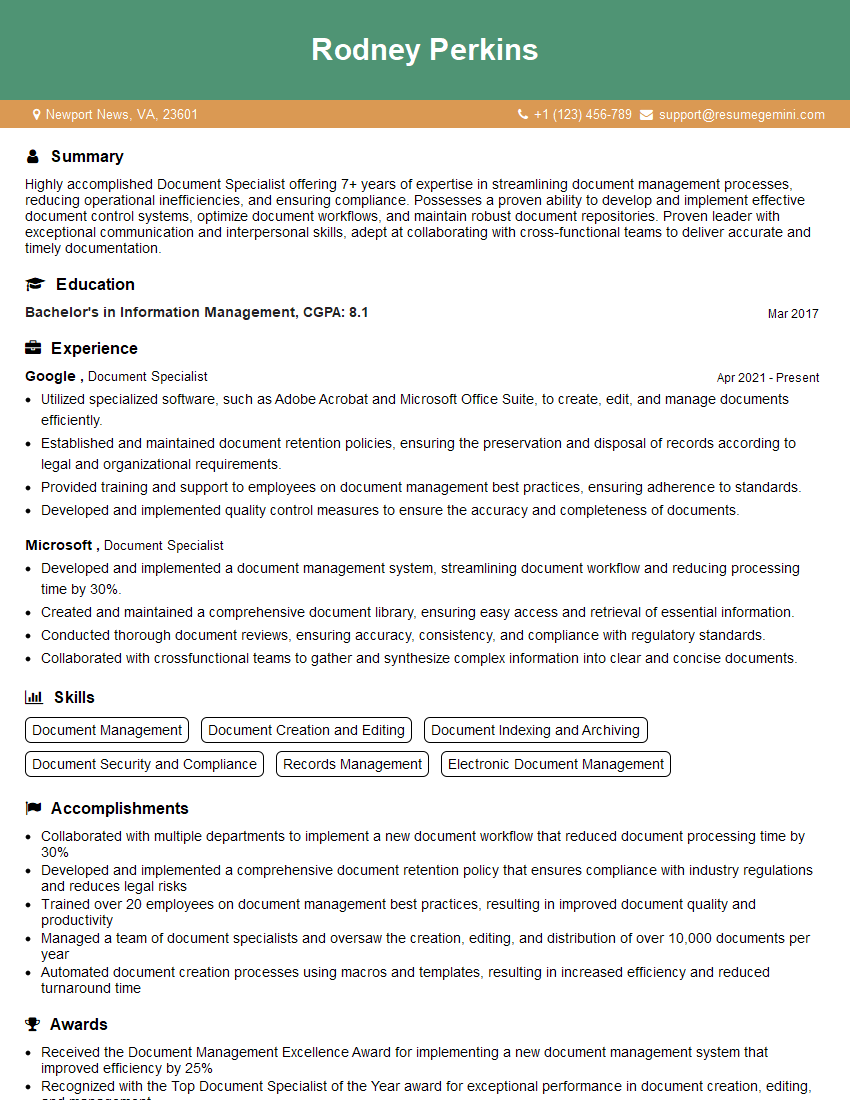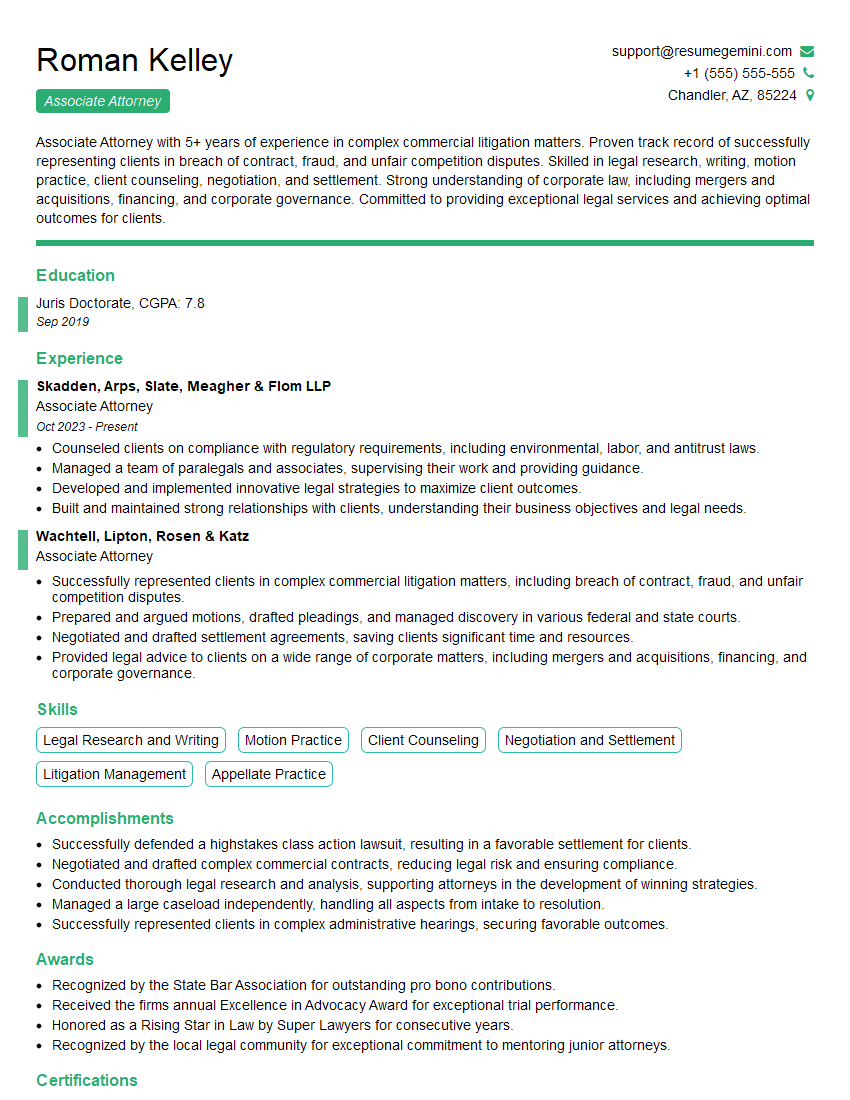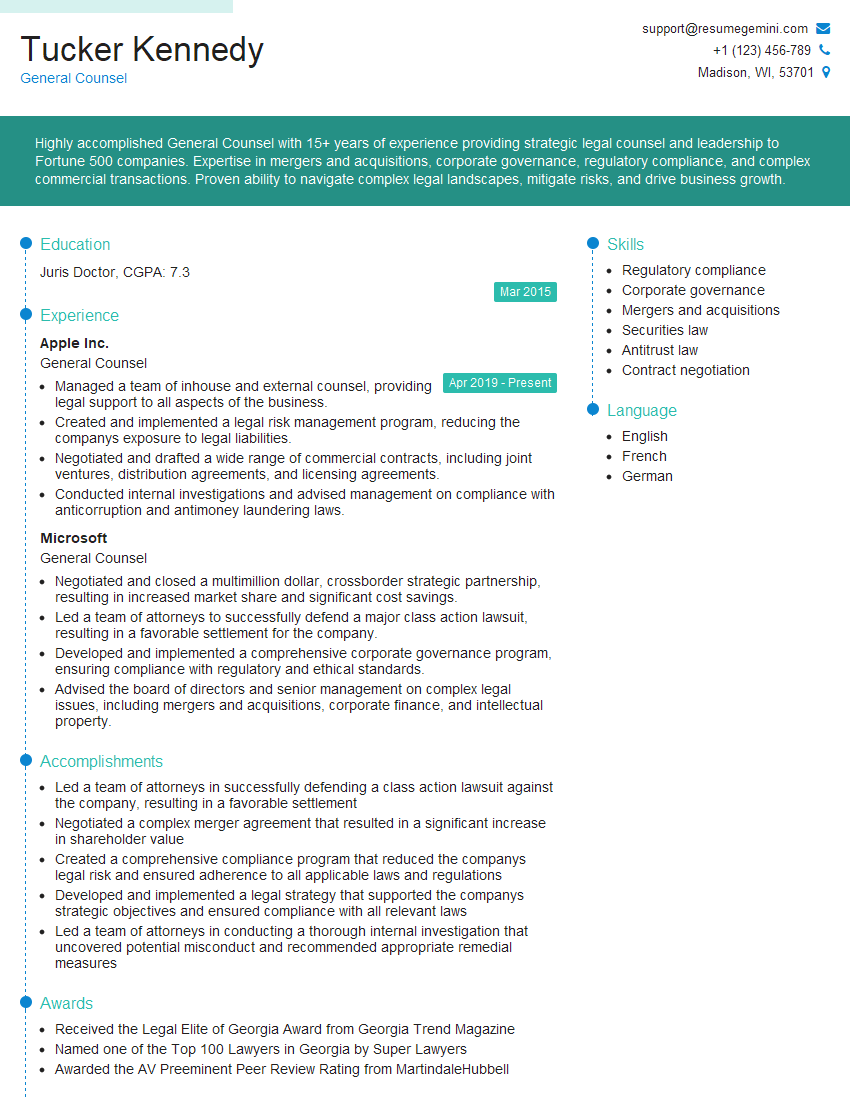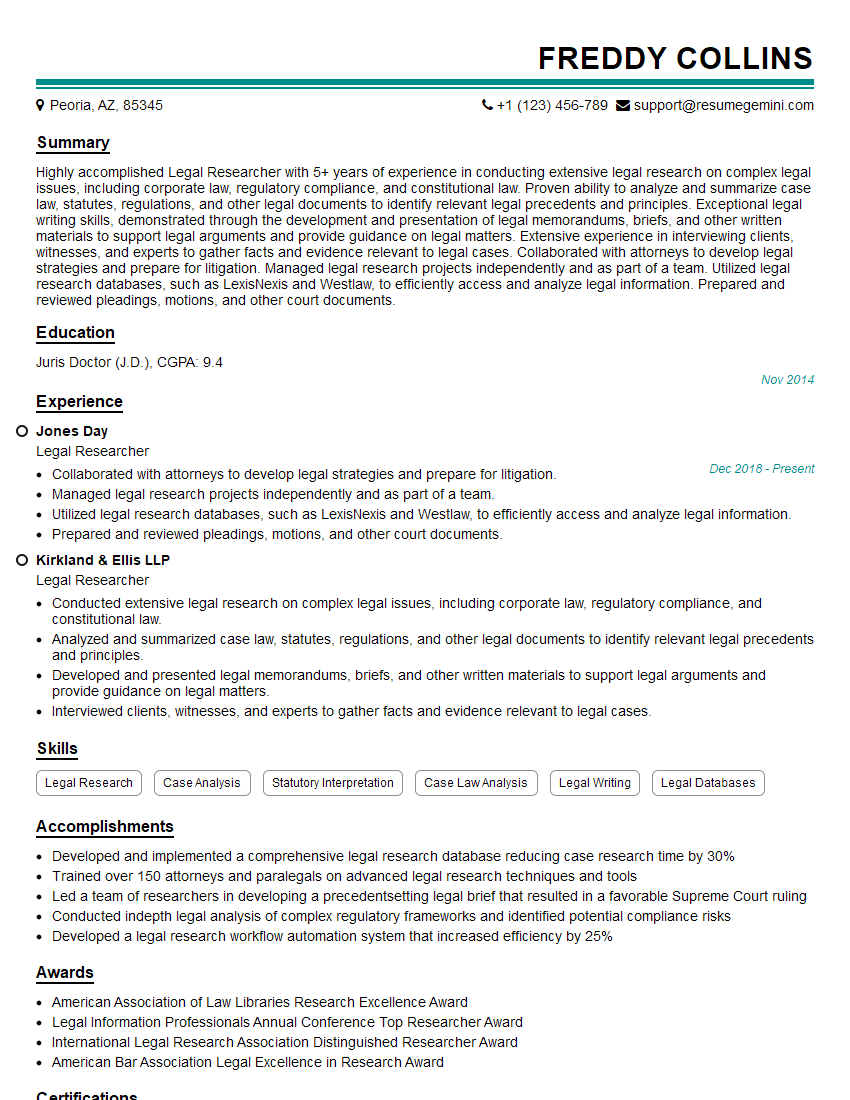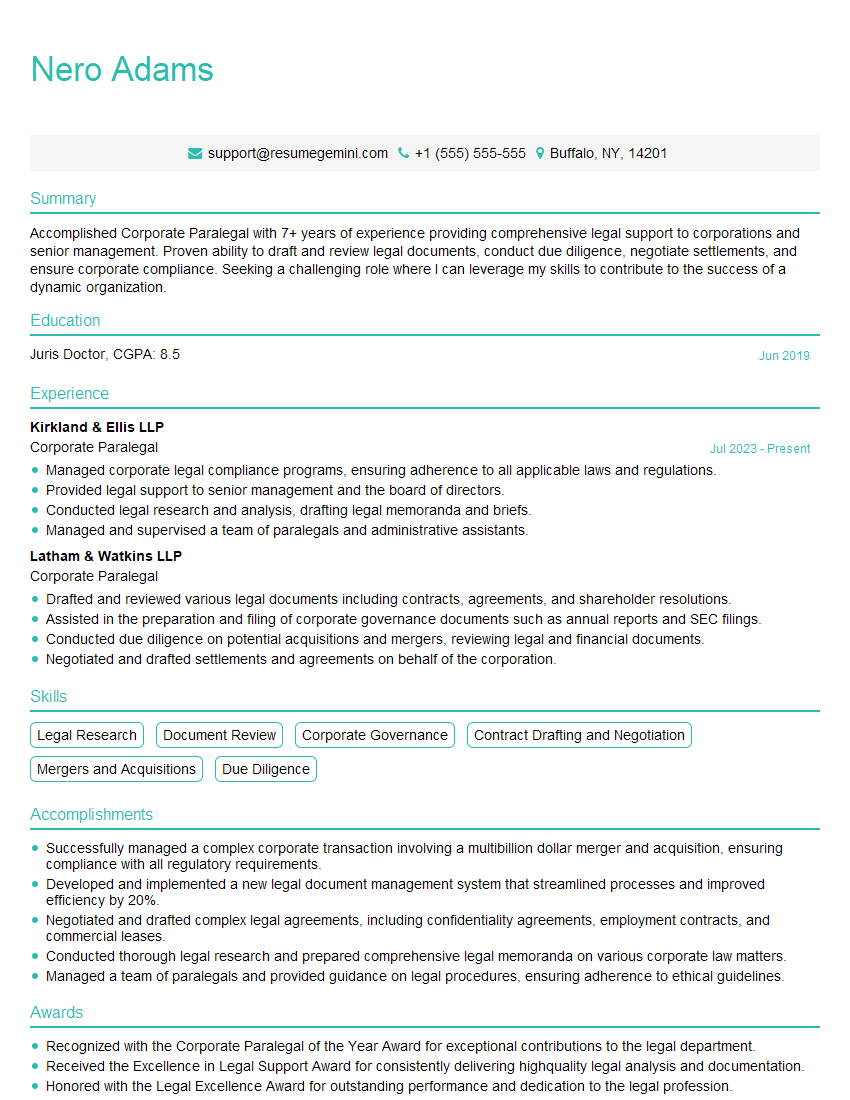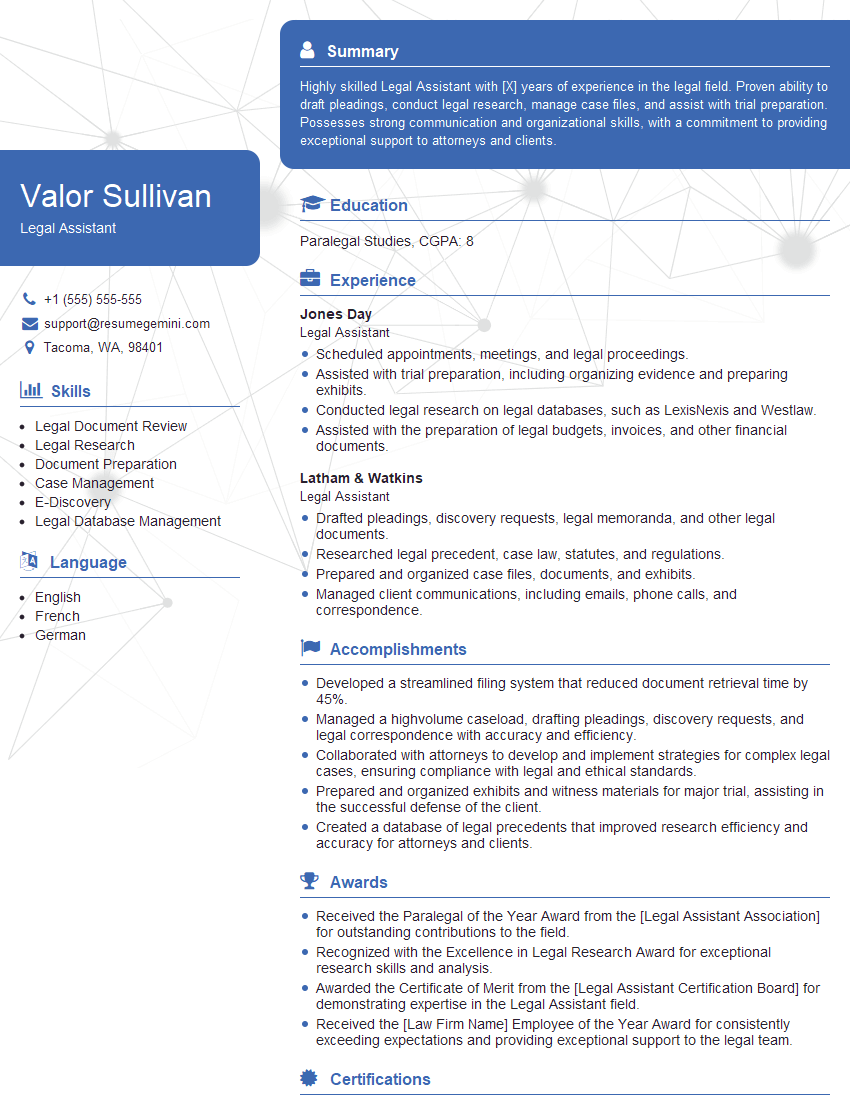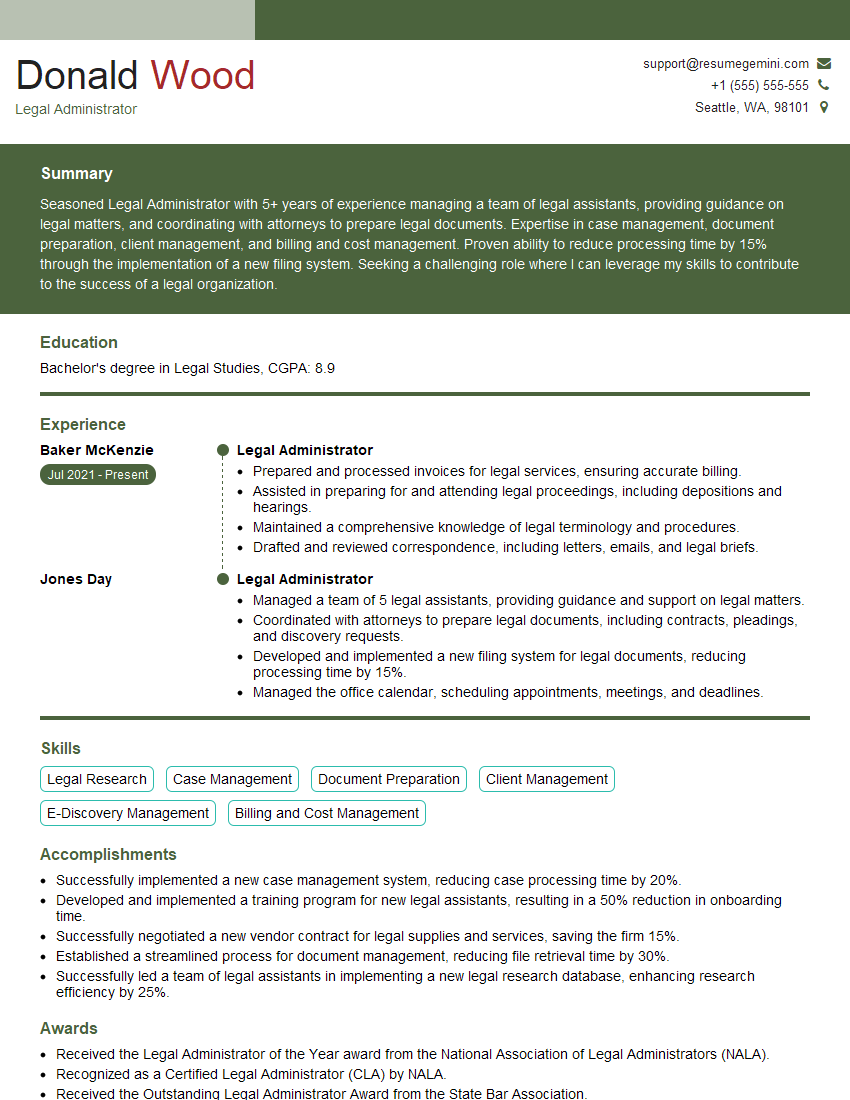Unlock your full potential by mastering the most common Preparing and Conducting Legal Correspondence interview questions. This blog offers a deep dive into the critical topics, ensuring you’re not only prepared to answer but to excel. With these insights, you’ll approach your interview with clarity and confidence.
Questions Asked in Preparing and Conducting Legal Correspondence Interview
Q 1. Explain your experience in drafting various types of legal correspondence, such as demand letters and settlement agreements.
Throughout my career, I’ve drafted a wide range of legal correspondence, from assertive demand letters to meticulously crafted settlement agreements. Demand letters, for instance, require a firm but professional tone, clearly outlining the client’s claim and the desired resolution. I carefully construct these to be persuasive yet avoid inflammatory language, ensuring they are legally sound and lay the groundwork for successful negotiation. Conversely, settlement agreements necessitate a highly detailed and precise approach. Each clause needs careful consideration to ensure it accurately reflects the parties’ agreement and protects my client’s interests. I frequently handle complex agreements involving multiple parties and intricate financial considerations, demanding a thorough understanding of contract law and negotiation strategies. My experience also includes drafting cease-and-desist letters, notices of default, and various other correspondence related to litigation and transactional matters. Each document type demands a specific approach, and I tailor my writing style to achieve the desired outcome in each unique circumstance.
Q 2. Describe your process for ensuring legal correspondence is accurate, concise, and compliant with all applicable rules and regulations.
Accuracy and compliance are paramount in legal correspondence. My process begins with a thorough understanding of the facts and applicable law. I meticulously review all supporting documentation, including contracts, emails, and case files. Then, I create a detailed outline, ensuring every point is addressed logically and concisely. I utilize clear and unambiguous language, avoiding jargon or technical terms unless absolutely necessary, and always define them when used. A crucial step is rigorous proofreading and editing, often involving a second pair of eyes to catch any potential errors or omissions. Furthermore, I am proficient in using various legal research tools to ensure my correspondence is fully compliant with all relevant rules, regulations, and ethical guidelines. This multi-step approach minimizes the risk of errors and strengthens the legal defensibility of our communications. Think of it like building a house – a strong foundation (thorough research and fact-finding) leads to a structurally sound building (accurate and compliant correspondence).
Q 3. How do you prioritize tasks when handling multiple legal correspondence requests simultaneously?
Managing multiple correspondence requests simultaneously demands effective prioritization. I employ a system that considers several factors: urgency, legal implications, and potential impact on the client. Time-sensitive matters, such as court filings or imminent deadlines, naturally take precedence. However, I also consider the potential legal ramifications of each request, prioritizing those with higher stakes or potential for significant consequences. Furthermore, I always communicate transparently with clients regarding timelines and expectations, keeping them informed of progress and any potential delays. I use project management software to track deadlines, assign priorities, and monitor progress, which allows me to allocate my time efficiently and avoid bottlenecks. It’s like a conductor leading an orchestra – each instrument (task) has its importance and needs to be played (completed) at the right time and volume (priority) to create a harmonious result.
Q 4. What software and tools are you proficient in for creating and managing legal documents?
My proficiency extends to several software programs crucial for creating and managing legal documents. I’m highly skilled in Microsoft Word, utilizing its advanced features for formatting, citation, and version control. I also use Westlaw and LexisNexis for legal research, ensuring I’m always abreast of the latest legal updates and precedents. Furthermore, I am familiar with document management systems such as NetDocuments and iManage, allowing for secure storage and collaborative editing of legal documents. Finally, I am adept at using various e-signature platforms to streamline the process of obtaining client approvals and executing legal agreements. These tools are integral to my workflow, allowing me to produce high-quality, compliant documents efficiently and securely.
Q 5. Describe a situation where you had to revise legal correspondence due to an error or omission. What was the outcome?
In one instance, I drafted a settlement agreement that inadvertently omitted a crucial clause regarding confidentiality. This was discovered during the final review stage by a colleague. I immediately corrected the error, issuing a revised agreement to all parties involved. We explained the oversight and its correction to all parties transparently. Fortunately, all parties were understanding and readily agreed to the revised document. This situation highlighted the importance of thorough proofreading and the value of having multiple eyes review critical documents. The outcome, while initially stressful, reinforced my commitment to precision and the importance of a collaborative review process to ensure the integrity of our work. The prompt correction prevented potential legal complications and maintained client trust.
Q 6. How do you ensure confidentiality and privilege in your handling of legal correspondence?
Confidentiality and privilege are central to my professional ethics. I strictly adhere to all applicable rules of professional conduct and client confidentiality agreements. Sensitive information is handled with the utmost care, ensuring it’s stored securely, both electronically and physically. Access is strictly limited to authorized personnel only. I use secure communication channels and encryption when transmitting confidential information electronically. Furthermore, I maintain detailed records of all communications and actions, demonstrating a commitment to transparency and accountability. Think of it as protecting a state secret – the highest level of care and security is implemented to avoid breaches of confidentiality and privilege.
Q 7. Explain your understanding of different legal writing styles and when to use each one.
My understanding of legal writing styles encompasses various approaches, each tailored to the specific context. Formal legal writing, characterized by precise language and a formal tone, is appropriate for court filings and official legal documents. Persuasive writing, which utilizes compelling arguments and evidence, is ideal for briefs and motions. Negotiating correspondence demands a balanced approach, combining firmness with collaboration to achieve a mutually acceptable resolution. Finally, informative writing, prioritizing clarity and accessibility, is best suited for explaining complex legal concepts to clients or non-legal audiences. The choice of writing style depends on the audience, purpose, and the desired outcome. It is crucial to understand and effectively utilize the most appropriate style for maximum impact and effectiveness.
Q 8. How do you handle situations where deadlines for legal correspondence are tight or unexpected?
Handling tight deadlines in legal correspondence requires a structured approach and prioritization. Think of it like a fire drill – you need a rapid response plan. My process begins with immediately assessing the urgency and scope of the task. This involves clarifying the specific requirements from the attorney, identifying any potential bottlenecks (like needing additional information from a client), and realistically estimating the time needed for research, drafting, review, and finalization.
Next, I prioritize tasks based on urgency and impact. Crucial documents requiring immediate action get top billing. I might employ time management techniques like the Pomodoro Technique to maintain focus and prevent burnout. If absolutely necessary, I will communicate transparently with the attorney about potential delays, offering realistic alternative solutions if possible. For instance, if a full brief is impossible within the deadline, a shorter, more targeted communication can be submitted immediately, followed by a complete document as soon as possible.
Finally, I always double-check the final document for accuracy and completeness before submitting it. This careful attention to detail mitigates the risk of errors, even in high-pressure situations. In essence, it’s about combining efficient workflow with clear communication to navigate tight deadlines successfully.
Q 9. What is your experience with e-filing and electronic document management systems?
I have extensive experience with e-filing systems, including CM/ECF, and various electronic document management systems (EDMS) like Relativity and iManage. My proficiency extends beyond simply uploading documents; I understand the nuances of each system, including formatting requirements, metadata tagging, and security protocols. For example, I’m well-versed in using CM/ECF’s specific formatting and filing procedures to ensure timely and successful submissions, avoiding potential rejections due to technical errors. With EDMS, my expertise involves implementing robust folder structures, implementing version control, and maintaining efficient search capabilities to streamline document retrieval.
I am adept at managing large volumes of electronic documents, ensuring efficient organization and easy access for both myself and the legal team. This includes using advanced search functionalities to locate specific documents quickly and accurately, saving considerable time and improving overall efficiency. I am also experienced in implementing and adhering to strict security measures when handling sensitive client data in these electronic systems.
Q 10. Describe your process for proofreading and editing legal documents to ensure accuracy and clarity.
My proofreading and editing process is meticulous and multi-layered. It’s not just about catching typos; it’s about ensuring legal accuracy and clarity. I typically begin with a comprehensive review of the document’s content, focusing on the logical flow of arguments and ensuring that all legal points are addressed accurately and completely. This often involves referencing the relevant case law and statutes.
Next, I perform a thorough grammatical and stylistic review, checking for errors in spelling, punctuation, grammar, and sentence structure. This phase also involves ensuring consistent formatting and citation styles. After this, I conduct a final review for clarity and conciseness, ensuring that the document is easily understandable and free of ambiguity. I often use tools such as grammar checkers and style guides but rely heavily on my own knowledge and experience to maintain high standards of accuracy. Think of it as polishing a diamond—several steps of careful attention to detail are required to make it shine. I often use a ‘fresh eyes’ approach, taking a break before a final review to ensure I’m not overlooking anything.
Q 11. How familiar are you with various legal citation formats (e.g., Bluebook, ALWD)?
I am proficient in several legal citation formats, including the Bluebook (20th edition and current updates), ALWD, and various other citation styles as needed by different courts or jurisdictions. My understanding extends beyond simply knowing the rules; I can apply them accurately and consistently across various types of legal documents, such as briefs, motions, and memoranda. I understand the importance of maintaining consistent citation throughout a document and the consequences of inaccurate citations.
My knowledge also encompasses the underlying principles of legal citation, such as the proper use of pincites, parallel citations, and the treatment of different sources. I can quickly adapt to different citation styles and ensure the accuracy and consistency of citations, ensuring that any legal correspondence I prepare complies with the specified style guidelines. If a new citation style is needed for a specific project I readily research the required guidelines and implement them effectively.
Q 12. How do you manage sensitive information contained within legal correspondence?
Managing sensitive information is paramount in legal correspondence. I adhere strictly to confidentiality protocols, both physical and digital. Physically, I ensure documents are stored securely, using locked filing cabinets and secure areas. Digitally, I utilize password-protected files, encrypted drives, and secure servers compliant with all relevant data privacy regulations. This includes adhering to the firm’s data security policies and relevant legal frameworks like GDPR and CCPA.
Access to sensitive information is strictly controlled. I utilize access control lists to limit access to authorized personnel only. I am trained in data security best practices and am always vigilant about potential security risks. Moreover, I understand the importance of shredding physical documents securely and deleting electronic files appropriately when they are no longer needed. Data security is not an afterthought; it is an integral part of my daily workflow.
Q 13. Explain your experience with legal research and how it impacts the creation of legal correspondence.
Legal research is fundamental to creating effective legal correspondence. My experience encompasses a wide range of research methods, from using Westlaw and LexisNexis to conducting thorough library research and utilizing secondary sources like law review articles. I am adept at crafting precise search queries, identifying relevant case law, statutes, and regulations, and synthesizing the information effectively.
The research process profoundly impacts the content and quality of the correspondence. A strong understanding of relevant laws and precedents ensures the document is factually accurate, legally sound, and persuasive. For example, when preparing a motion, my research informs the arguments presented, strengthens the legal basis for the claims, and identifies potential counter-arguments. Essentially, solid legal research forms the foundation of a well-written and effective legal document.
Q 14. Describe your understanding of the importance of maintaining a professional tone in all legal communication.
Maintaining a professional tone is crucial for effective legal communication. It conveys respect for the court, opposing counsel, and clients. A professional tone is characterized by clarity, conciseness, objectivity, and respect. It avoids inflammatory language, personal attacks, or emotional outbursts, opting instead for a factual and reasoned presentation. Imagine it as building a bridge—a professional tone fosters collaboration and understanding.
I strive to use formal language, avoid slang, and maintain a consistent and neutral tone throughout all my correspondence. I understand that the tone of the communication significantly impacts its reception and effectiveness. A poorly written, unprofessional document can undermine the credibility of the legal argument and negatively impact the client’s case. Therefore, I always carefully consider the tone of my writing to ensure it aligns with the professional standards of the legal profession and the specific context of the situation.
Q 15. How do you adapt your communication style to different audiences (e.g., clients, judges, opposing counsel)?
Adapting communication style is crucial for effective legal correspondence. Think of it like tailoring a suit – you wouldn’t wear the same outfit to a court hearing as you would to a client meeting. With clients, my approach is empathetic and reassuring, focusing on clear, concise explanations avoiding complex legal jargon. I prioritize building trust and understanding. For example, if explaining a complex contract, I use analogies and plain language, making sure the client understands the implications. With judges, I maintain a formal and respectful tone, emphasizing precision, accuracy, and adherence to legal procedure. My language is highly formal and precise, with every sentence carefully crafted to support my argument. Opposing counsel requires a different tact – professional, assertive but respectful, aiming for clarity and efficiency in negotiations. I avoid emotional language and focus on presenting facts and legal arguments in a structured manner. For example, if there’s a discovery dispute, my correspondence is factual and cites relevant case law, without inflammatory language.
Career Expert Tips:
- Ace those interviews! Prepare effectively by reviewing the Top 50 Most Common Interview Questions on ResumeGemini.
- Navigate your job search with confidence! Explore a wide range of Career Tips on ResumeGemini. Learn about common challenges and recommendations to overcome them.
- Craft the perfect resume! Master the Art of Resume Writing with ResumeGemini’s guide. Showcase your unique qualifications and achievements effectively.
- Don’t miss out on holiday savings! Build your dream resume with ResumeGemini’s ATS optimized templates.
Q 16. How do you handle difficult or demanding clients or superiors regarding legal correspondence?
Handling demanding clients or superiors requires a calm, professional, and proactive approach. First, I listen attentively to their concerns, acknowledging their perspective before offering solutions. Clear and consistent communication is paramount; I keep them updated on progress and proactively address potential issues. For instance, if a client is frustrated by delays, I explain the reasons transparently, offering realistic timelines and alternative solutions. If a superior has specific requests, I clarify my understanding and outline any potential challenges, proposing alternative strategies if necessary. I document all interactions meticulously, ensuring a clear record of communication and agreements. This proactive and well-documented approach helps prevent misunderstandings and manage expectations effectively. It’s about building a professional relationship based on mutual respect and understanding, even amidst challenges.
Q 17. How do you ensure correspondence aligns with firm or company policies and procedures?
Adherence to firm policies and procedures is essential for maintaining consistency, professionalism, and legal compliance. Our firm utilizes a comprehensive style guide that dictates formatting, tone, and citation standards. Before drafting any correspondence, I review the relevant firm policies. For example, we have specific protocols for handling sensitive client information, confidentiality agreements, and electronic communication. I carefully review all correspondence for compliance before sending it. Our firm also uses a document management system that ensures version control and easy access to previously used templates, ensuring consistency and efficiency. Regular training and updates keep the team abreast of any policy changes, ensuring we are always in compliance with the firm’s and relevant legal guidelines.
Q 18. Describe your experience working collaboratively with legal teams on correspondence projects.
Collaborative work is a cornerstone of legal practice. I’ve extensively worked with paralegals, associates, and senior partners on various correspondence projects. In a recent case involving a complex commercial dispute, I collaborated with a junior associate to draft pleadings. I guided him on legal research and ensured the documents accurately reflected our strategy. We regularly reviewed drafts, incorporating feedback and ensuring consistency in tone and style. I’ve also worked with paralegals to organize and prepare voluminous documents for discovery. Effective collaboration relies on clear communication, defined roles, and a shared understanding of objectives. Utilizing shared document platforms and regular team meetings help maintain transparency and ensure everyone is on the same page. This collaborative approach not only increases efficiency but also ensures the quality and accuracy of the final product.
Q 19. What strategies do you use to organize and manage large volumes of legal documents and correspondence?
Managing large volumes of legal documents requires a systematic approach. I utilize a combination of electronic document management systems and robust filing structures. The system allows for keyword searching, version control, and efficient retrieval of documents. I create detailed filing systems, categorizing documents by case name, type of document, and date. For example, within a case file, I might have subfolders for pleadings, discovery, correspondence, and exhibits. I also leverage technology to automate tasks, such as using optical character recognition (OCR) to make paper documents searchable. Regular purging of obsolete files is crucial to maintain an organized and efficient system. This organized approach significantly reduces the time spent searching for documents and ensures quick access to information when needed. This approach is vital for meeting deadlines and managing caseloads effectively.
Q 20. How do you stay updated on changes in legal rules and regulations that might affect your correspondence?
Staying updated on legal changes is a continuous process. I subscribe to legal news services and attend continuing legal education (CLE) courses to remain informed about relevant case law, statutes, and regulatory changes. I regularly monitor changes to rules of civil procedure and evidence that directly impact how legal correspondence is drafted and filed. I also actively participate in professional organizations and networks to share knowledge and stay abreast of industry trends. The ability to quickly identify and adapt to legal changes is essential to provide effective and compliant legal services. This involves actively reviewing and updating firm policies and procedures to reflect these changes and training colleagues on the implications of these updates.
Q 21. Describe your experience with using legal templates and how you adapt them to specific circumstances.
Legal templates are invaluable tools that standardize formatting and ensure consistency. Our firm maintains a library of pre-approved templates for various types of correspondence, including demand letters, discovery requests, and motions. I frequently use these templates as a starting point, customizing them to fit the specific circumstances of each case. This saves time and ensures that all correspondence meets firm standards. For example, when drafting a demand letter, I use a template that ensures all necessary information, such as client details, relevant facts, and legal arguments, are included in a clear and concise manner. However, I adapt these templates based on the unique facts of each case. This might include tailoring the language to reflect the specific legal claims or modifying the structure to address a unique situation. This balance between standardization and customization is key to efficient and effective legal correspondence.
Q 22. How would you handle a situation where you discover an error in a document that has already been sent?
Discovering an error in a sent document is serious. My immediate response prioritizes damage control and transparency. First, I’d assess the severity of the error. Is it a minor typographical error, or a substantial factual inaccuracy that could alter the legal standing of the document?
For minor errors, a quick, apologetic email acknowledging the mistake and attaching a corrected version is usually sufficient. I’d clearly label the corrected version as such (e.g., ‘Amended Letter of Agreement’).
For significant errors, the situation is more complex. I would immediately inform my supervising attorney. We would collaboratively decide on the best course of action, which might involve issuing a formal withdrawal of the original document and sending a replacement with a clear explanation. Transparency and prompt correction are key to maintaining credibility.
Imagine sending a contract with the wrong date – a simple correction won’t suffice. A formal retraction with a revised contract and an apology is necessary. Each situation necessitates a tailored approach; there’s no one-size-fits-all solution.
Q 23. What is your experience with creating correspondence related to specific legal areas (e.g., contracts, litigation, corporate)?
My experience spans various legal areas. In contract law, I’ve drafted and reviewed numerous agreements, from simple NDAs to complex commercial contracts, ensuring clarity, enforceability, and compliance with relevant regulations. This includes meticulous attention to detail, addressing potential ambiguities, and adhering to specific legal requirements.
In litigation, I’ve assisted in preparing pleadings, motions, discovery requests, and responses, adhering to strict court rules and deadlines. I understand the importance of concise, persuasive language while maintaining professionalism and ethical considerations.
Within corporate law, my work has included drafting shareholder agreements, corporate resolutions, and other internal governance documents, ensuring accuracy and compliance with corporate statutes. This requires understanding complex corporate structures and their legal implications.
Q 24. How do you prioritize the urgency and importance of different legal correspondence tasks?
Prioritization of legal correspondence relies on a clear understanding of deadlines, potential consequences of delay, and the overall strategic goals of the case or transaction. I use a combination of methods. First, I meticulously review each task, assigning a level of urgency based on deadlines (court filings, contract deadlines etc.) and potential impact (risk of penalties, harm to client reputation etc.).
I use a project management system (e.g., a task management software) to track all correspondence, assigning deadlines and prioritizing based on urgency and importance. Time-sensitive tasks, such as court filings with strict deadlines, are prioritized over tasks with less immediate consequences. I employ a system such as the Eisenhower Matrix (Urgent/Important) to further categorize my tasks. A visual representation of tasks allows me to clearly prioritize and manage workload efficiently.
Q 25. Explain your experience using document automation tools to improve efficiency.
I have extensive experience utilizing document automation tools like HotDocs and MS Word’s Mail Merge functionalities to streamline the creation of legal documents. These tools greatly enhance efficiency by automating repetitive tasks, reducing the risk of errors, and ensuring consistency across documents.
For example, using HotDocs, I can create templates for standard contracts or letters. These templates include placeholders that automatically populate with client-specific information, significantly speeding up the process. This not only saves time but also maintains consistency in language and formatting, minimizing the risk of errors and omissions.
Furthermore, the ability to incorporate conditional logic allows the creation of dynamic documents that adapt to various scenarios. This helps prevent errors associated with manual data entry and ensures all generated documents are relevant and accurate. For example, a clause might be added only if specific criteria are met in the input data.
Q 26. Describe a time you had to explain a complex legal concept in simple terms through written communication.
I once had to explain the concept of ‘piercing the corporate veil’ to a client who lacked a legal background. This complex legal concept refers to circumstances where a court disregards the separate legal entity of a corporation, holding its shareholders personally liable for its debts.
To simplify this, I used a relatable analogy. Imagine a corporation as a house protected by a strong wall. Normally, creditors can only pursue the house (the corporation’s assets). However, if the shareholder acts fraudulently or uses the corporation to commit illegal acts (e.g., deliberately avoiding debt), the court might ‘pierce’ the wall, holding the shareholder personally liable for the debts, making them responsible for repayment even if it means using their personal assets.
This analogy helped the client understand the concept and its potential implications much more effectively than using complex legal jargon.
Q 27. How do you track and manage the status of all outgoing and incoming legal correspondence?
Tracking and managing correspondence is crucial for maintaining organization and accountability. I utilize a combination of methods. First, I use a dedicated case management system to document all incoming and outgoing communications. This system allows me to track the status of each communication, its recipient, and any relevant deadlines.
Second, I employ a robust filing system (both physical and digital). Every document is carefully categorized and filed to easily retrieve information when needed. This ensures that all correspondence is readily accessible and well-organized.
Finally, I use email filters and folders to manage incoming emails, creating separate folders for ongoing cases, individual clients, and general communications. This facilitates efficient management and ensures no correspondence is overlooked.
Q 28. How do you maintain version control of legal documents throughout the drafting and revision process?
Maintaining version control is vital in legal practice to prevent confusion and ensure that everyone is working with the most up-to-date version of a document. I use a combination of techniques. Primarily, I utilize cloud-based document management systems such as Dropbox, Google Drive, or SharePoint. These systems automatically track different versions and allow easy comparison of changes.
Within these systems, I employ a clear naming convention for documents. I typically include the date and a revision number in the filename, such as ‘Contract_20240308_v3.docx.’ This allows for quick identification of the most current version.
Additionally, I consistently utilize the ‘track changes’ feature in Microsoft Word during the drafting and revision process. This allows me to keep track of all amendments and easily revert to previous versions if necessary. Combining these methods ensures a clear and auditable history of revisions, leaving a trail for review and analysis.
Key Topics to Learn for Preparing and Conducting Legal Correspondence Interview
- Understanding Legal Writing Principles: Mastering clarity, conciseness, and precision in legal communication. This includes understanding the nuances of legal terminology and avoiding ambiguity.
- Formatting and Structure of Legal Documents: Gain proficiency in formatting various legal correspondence, including letters, briefs, motions, and emails, adhering to established legal conventions and firm-specific style guides.
- Client Communication Strategies: Learn effective techniques for communicating complex legal information to clients clearly and empathetically, tailoring your approach to their understanding and needs.
- Legal Research and Citation: Develop your skills in conducting thorough legal research and accurately citing relevant case law, statutes, and regulations using appropriate citation formats (e.g., Bluebook).
- Ethical Considerations in Legal Writing: Understand and apply ethical rules and professional responsibilities related to legal correspondence, ensuring accuracy, truthfulness, and avoidance of misrepresentation.
- Proofreading and Editing Techniques: Develop sharp proofreading and editing skills to ensure flawless grammar, spelling, punctuation, and adherence to style guidelines before sending any correspondence.
- E-Discovery and Document Management: Familiarize yourself with the processes and best practices involved in managing and handling legal documents in the context of electronic discovery.
- Practical Application: Prepare examples of legal correspondence you have drafted (even hypothetical scenarios) to demonstrate your skills during the interview. Be ready to discuss the challenges you faced and how you overcame them.
- Problem-Solving: Practice analyzing hypothetical legal scenarios and determining the most appropriate and effective way to communicate the necessary information through written correspondence.
Next Steps
Mastering the art of preparing and conducting legal correspondence is crucial for career advancement in the legal field. Strong written communication skills are highly valued and directly contribute to your success as a legal professional. To enhance your job prospects, focus on creating an ATS-friendly resume that highlights your skills and experience effectively. We highly recommend using ResumeGemini to build a professional and impactful resume. ResumeGemini provides you with the tools and resources you need to craft a standout resume, and examples of resumes tailored to Preparing and Conducting Legal Correspondence are available to guide you.
Explore more articles
Users Rating of Our Blogs
Share Your Experience
We value your feedback! Please rate our content and share your thoughts (optional).
What Readers Say About Our Blog
Hi, I’m Jay, we have a few potential clients that are interested in your services, thought you might be a good fit. I’d love to talk about the details, when do you have time to talk?
Best,
Jay
Founder | CEO


